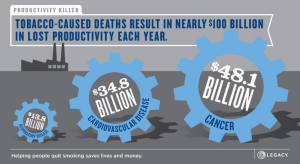Tobacco use holds a top spot among the health risks employers focus on through their wellness programs.
You may wonder why. After all, public bans on tobacco use at work, restaurants and even in homes must be making a dent, right?
Well, yes and no. Tobacco use steadily declined from 2000 to 2005, according to the Centers for Disease Control, but it has stalled since then. Currently, 20 percent still smoke.
Half of companies encourage employees to quit
That’s a problem for employers who face the consequences and related costs. And those costs are significant, as represented in a series of infographics and videos posted on Fast Company.
 Responses to tobacco use by employers vary.
Responses to tobacco use by employers vary.
Some 49 percent of companies use incentives to encourage employees to quit, according to the TowersWatson 2011/2012 Staying@Work Survey report. That percentage has increased from 40 percent reported in 2009.
Many employers take a tougher stance and apply a surcharge based on tobacco user status. Another 32 percent of employers had surcharges in place in 2011 and 14 percent plan to implement surcharges in 2012, according to this same report. Though they use these incentives (or penalties), habits are hard to break.
Companies saw a low 8 percent participation in their tobacco cessation programs — with or without incentives. And so companies have expanded their approach to affect their environment. In the U.S., 49 percent of companies have banned smoking around their facilities. An unknown number have instituted a no-hire tobacco policy.
Moving the dial isn’t easy
Employers may be struggling with the same flatlining with tobacco users that we as a country are seeing.
Many of my clients struggle to reduce their population of tobacco users to below the 20 percent threshold. They’re using a combination of tactics to tackle the problem: targeted communications, peer-to-peer support, integrated support that combines tobacco quit programs with nutrition and stress management counseling, and the availability of discounted quit programs and quit aids.
One of my clients officially becomes a tobacco-free workplace next week on July 1, 2012. As Fast Company notes, employers must keep their eyes on this ball and relentlessly measure and adjust their approach. Employers may also want to add their voice of support for tobacco bans, at work and elsewhere, and for taxes — two effective ways to reduce tobacco use.
Moving the dial on tobacco use clearly isn’t easy, especially with new recruits constantly being sought. Based on the number of youth who are relentlessly targeted by tobacco companies — and are succumbing to their bait — employers must be prepared for the long road they’ve yet to travel.
This was originally published on Fran Melmed’s free-range communication blog.
